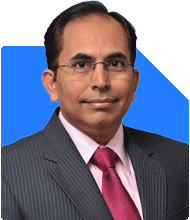Ramalingam Kalirajan |10908 Answers |Ask -Follow
Mutual Funds, Financial Planning Expert - Answered on May 23, 2024
He has an MBA in finance from the University of Madras and is a certified financial planner.
He is the director and chief financial planner at Holistic Investment, a Chennai-based firm that offers financial planning and wealth management advice.... more

I want to invest Rs. 70 lacs at the moment and wanting a corpus of Rs. 1.2 cr for my daughters overseas education in the next 5-5.5 years. Where should i invest?
Understanding Your Financial Goal
You aim to grow ?70 lakhs into ?1.2 crores within 5 to 5.5 years for your daughter's overseas education. This goal requires a strategic investment plan that balances growth and risk.
Your commitment to securing your daughter's future through overseas education is commendable. Planning well in advance demonstrates foresight and dedication to providing the best opportunities for your child.
Evaluating Investment Options
Equities and Equity Mutual Funds
Equities can provide high returns, essential for your goal. Investing in diversified equity mutual funds or blue-chip stocks can help achieve significant growth. However, equities come with volatility, so a balanced approach is necessary.
Actively Managed Mutual Funds
Actively managed funds, overseen by experienced fund managers, can outperform index funds. These funds adapt to market conditions and can potentially deliver higher returns. Investing through a certified financial planner (CFP) ensures professional guidance and tailored strategies.
Debt Funds
Debt funds offer stability and are less volatile compared to equities. Including debt funds in your portfolio can provide balance and reduce overall risk. They are crucial for safeguarding part of your investment against market downturns.
Balanced or Hybrid Funds
Balanced or hybrid funds invest in both equities and debt instruments. They offer a mix of growth and stability, making them suitable for medium-term goals like yours. These funds aim to balance risk and return effectively.
Creating a Diversified Portfolio
Equity Mutual Funds
Allocate a significant portion of your investment to equity mutual funds. Choose funds with a strong track record and consistent performance. Diversify across large-cap, mid-cap, and multi-cap funds to spread risk and capture growth across market segments.
Debt Funds
Invest a portion in debt funds to ensure stability. Opt for short-term or medium-term debt funds, which can provide steady returns with lower risk compared to long-term debt funds.
Balanced Funds
Consider investing in balanced funds to blend growth and stability. These funds dynamically allocate assets between equities and debt, adjusting to market conditions. They can offer a smoother investment journey with reasonable returns.
Regular Review and Adjustment
Monitoring Performance
Regularly review your portfolio’s performance. This helps in making timely adjustments based on market trends and your investment goals. Monitoring ensures that your investment stays on track to meet your target.
Rebalancing Portfolio
Rebalance your portfolio periodically to maintain the desired asset allocation. Rebalancing involves shifting funds between equities and debt based on market performance and your risk tolerance. It helps in managing risk and optimizing returns.
Professional Guidance
Importance of a Certified Financial Planner
Engaging a certified financial planner (CFP) can significantly enhance your investment strategy. A CFP offers personalized advice, aligns your investments with your goals, and helps navigate complex financial decisions.
Benefits of Actively Managed Funds
Actively managed funds, recommended by CFPs, can provide superior returns by leveraging market expertise. These funds are more adaptable to market changes compared to index funds, making them suitable for achieving specific financial goals.
Avoiding Common Pitfalls
Disadvantages of New Fund Offers (NFOs)
NFOs often lack a track record, making it challenging to assess their performance. Established funds with a proven history are generally safer and more predictable choices.
Risks of Sectoral Funds
Sectoral funds focus on specific industries, which can be risky due to sector volatility. Diversified funds spread across various sectors offer a more balanced risk-return profile.
Conclusion
Investing ?70 lakhs to reach ?1.2 crores in 5 to 5.5 years for your daughter’s education requires a balanced and strategic approach. Diversify across equity mutual funds, debt funds, and balanced funds. Regularly review and rebalance your portfolio to stay on track. Seek guidance from a certified financial planner to optimize your investment strategy.
Your proactive approach and dedication to your daughter’s future are admirable. By following these steps, you can achieve your financial goal with confidence and security.
Best Regards,
K. Ramalingam, MBA, CFP,
Chief Financial Planner,
www.holisticinvestment.in
You may like to see similar questions and answers below
Ramalingam Kalirajan |10908 Answers |Ask -Follow
Mutual Funds, Financial Planning Expert - Answered on Jun 11, 2024
Ramalingam Kalirajan |10908 Answers |Ask -Follow
Mutual Funds, Financial Planning Expert - Answered on Dec 17, 2025
Janak Patel |72 Answers |Ask -Follow
MF, PF Expert - Answered on Dec 17, 2025
Ramalingam Kalirajan |10908 Answers |Ask -Follow
Mutual Funds, Financial Planning Expert - Answered on Dec 19, 2025
Ramalingam Kalirajan |10908 Answers |Ask -Follow
Mutual Funds, Financial Planning Expert - Answered on Dec 17, 2025
Ramalingam Kalirajan |10908 Answers |Ask -Follow
Mutual Funds, Financial Planning Expert - Answered on Dec 20, 2025
Ramalingam Kalirajan |10908 Answers |Ask -Follow
Mutual Funds, Financial Planning Expert - Answered on Dec 20, 2025
Naveenn Kummar |237 Answers |Ask -Follow
Financial Planner, MF, Insurance Expert - Answered on Dec 20, 2025
Ramalingam Kalirajan |10908 Answers |Ask -Follow
Mutual Funds, Financial Planning Expert - Answered on Dec 19, 2025
Nayagam P P |10859 Answers |Ask -Follow
Career Counsellor - Answered on Dec 19, 2025
Ramalingam Kalirajan |10908 Answers |Ask -Follow
Mutual Funds, Financial Planning Expert - Answered on Dec 19, 2025
Ramalingam Kalirajan |10908 Answers |Ask -Follow
Mutual Funds, Financial Planning Expert - Answered on Dec 19, 2025
Ramalingam Kalirajan |10908 Answers |Ask -Follow
Mutual Funds, Financial Planning Expert - Answered on Dec 19, 2025
Radheshyam Zanwar |6751 Answers |Ask -Follow
MHT-CET, IIT-JEE, NEET-UG Expert - Answered on Dec 19, 2025
Radheshyam Zanwar |6751 Answers |Ask -Follow
MHT-CET, IIT-JEE, NEET-UG Expert - Answered on Dec 19, 2025























